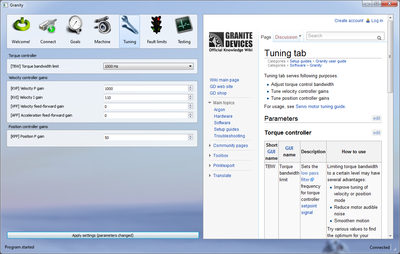Difference between revisions of "Granity user guide/Tuning"
From Granite Devices Knowledge Wiki
| [checked revision] | [checked revision] |
m (Text replacement - "{{param|GUI}}" to "GUI") |
|||
| Line 48: | Line 48: | ||
| AD || Anti-dither || Motor dithering/zero error hunting reduction function (in current firmware: no effect) || Useful in future firmware | | AD || Anti-dither || Motor dithering/zero error hunting reduction function (in current firmware: no effect) || Useful in future firmware | ||
|} | |} | ||
| + | |||
| + | ===Torque cogging & ripple compensation=== | ||
| + | {| class="wikitable" | ||
| + | |- | ||
| + | ! Short [[GUI]] name !! [[GUI]] name !! Description !! How to use | ||
| + | |- | ||
| + | | TRF1 || Cogging compensation function || Selects the function of compensator || rowspan=4| See [[Configuring cogging torque compensation]] | ||
| + | |- | ||
| + | | TRA1 || Cogging compensation current|| Adjusts the amplitude of summed compensating torque command | ||
| + | |- | ||
| + | | TRF2 || Torque ripple compensation function || Selects the function of compensator | ||
| + | |- | ||
| + | | TRA2 || Torque ripple compensation amplitude || Adjust the modulation depth of compensator | ||
| + | |- | ||
| + | |} | ||
| + | |||
{{next|[[Granity user guide/Fault limits]]}} | {{next|[[Granity user guide/Fault limits]]}} | ||
[[Category:Granity_user_guide]] | [[Category:Granity_user_guide]] | ||
Revision as of 23:16, 2 November 2015
Tuning tab serves following purposes:
- Adjust torque control bandwidth
- Tune velocity controller gains
- Tune position controller gains
See also:
- Servo motor tuning guide - procedures for finding optimal parameter values
- Signal path of motor drive - an illustration of how drive processes various signals and parameters
- Drive fault handling
Parameters
Torque controller
| Short GUI name | GUI name | Description | How to use |
|---|---|---|---|
| TBW | Torque bandwidth limit | Sets the low pass filter frequency for torque controller setpoint signal | Limiting torque bandwidth to a certain level may have several advantages:
Try various values to find the optimum for your system. Typically higher value allows setting higher velocity and position P gains giving more servo stiffness. Typically the optimum bandwidths are between 220-1500 Hz. If you wish to check torque controller step response in testing tab, then before testing set this value to maximum and also untick Goals/CIS. |
Velocity controller gains
| Short GUI name | GUI name | Description | How to use |
|---|---|---|---|
| KVP | Velocity P gain | The proportional gain of velocity controller | See Servo motor tuning guide. |
| KVI | Velocity I gain | The integral gain of velocity controller | |
| VFF | Velocity feed-forward gain | Velocity feed-forward gain | |
| AFF | Acceleration feed-forward gain | Acceleration feed-forward gain |
Position controller gains
| Short GUI name | GUI name | Description | How to use |
|---|---|---|---|
| KPP | Position P gain | The proportional gain of position controller | See Servo motor tuning guide. |
| PFF | Position feed-forward gain | Sets feed foward gain from position setpoint to velocity setpoint | Adjust to minimize position response overshooting. |
| AD | Anti-dither | Motor dithering/zero error hunting reduction function (in current firmware: no effect) | Useful in future firmware |
Torque cogging & ripple compensation
| Short GUI name | GUI name | Description | How to use |
|---|---|---|---|
| TRF1 | Cogging compensation function | Selects the function of compensator | See Configuring cogging torque compensation |
| TRA1 | Cogging compensation current | Adjusts the amplitude of summed compensating torque command | |
| TRF2 | Torque ripple compensation function | Selects the function of compensator | |
| TRA2 | Torque ripple compensation amplitude | Adjust the modulation depth of compensator |
| Read next |
